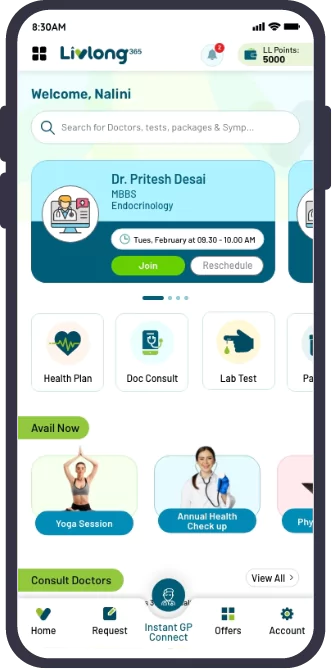What is breast ultrasound?
Breast ultrasound is an imaging test that is used to examine the breast tissue for any abnormalities. Additionally, it also helps the healthcare provider observe the blood flow inside the breasts. It is also sometimes referred to as breast sonography or a breast ultrasound scan.
In breast ultrasound, a sonographer uses a probe or transducer to ‘see’ the inside of the breasts. The transducer converts electricity into high-frequency sound waves and projects them through the body. The computer interprets the signals from the returning sound waves collected by the transducer and creates real-time visuals (images and videos) based on the pattern. Relevant visuals are captured and shared with the concerned doctor later that day or the next day. The test results are analysed by a healthcare provider and a relevant summary is shared with the doctor, which is included in the test report.
In a breast ultrasound, the technician examines the surrounding area of the breasts, including the armpits where lymph nodes are situated, over the sternum, and under the breasts. Doctors usually recommend a bilateral breast ultrasound, which examines both breasts, which examines both breasts. For this, the healthcare provider will add another Doppler probe to the transducer. Thus, modifying the breast ultrasound to a Doppler breast ultrasound allows the healthcare provider to observe the blood flow rate and the direction of the flow. The doctor will recommend a breast ultrasound in conjunction with other tests if the patient has a lump, unexplained pain or tenderness in their breasts, changes in the appearance or texture of their breasts, or discharge from the nipples.
Why is a breast ultrasound recommended?
Usually, doctors recommend a breast ultrasound in addition to or after a mammogram or physical examination of the breasts. If a mammogram shows any changes, doctors may recommend a breast ultrasound for people who have regular mammograms for pre-screening or to observe any changes in the breasts. A breast ultrasound can help the doctor make a diagnosis by examining a specific area of the breast.
Doctors may perform a breast ultrasound for the following reasons:
- To find out if the abnormality observed in other tests is a benign (or non-cancerous) growth, or a cyst, or a cancerous growth.
- To examine the breast of a woman who is at high risk of breast cancer.
- To guide the surgeon during a biopsy (taking a sample of tissue or fluid from inside the body) or other procedures
The doctors recommend that pregnant women and people who cannot undergo test procedures that use radiation or who have dense breasts undergo breast sonography or ultrasound. A breast ultrasound scan may also be recommended when the mammography machine is not available.
Preparing for a breast ultrasound
One should not apply anything to the skin before the ultrasound after showering as the skincare products may interfere with the test results. The patient does not need to shave to prepare for a breast ultrasound, as the hair on the skin does not interfere with getting clear visuals during the test. The pathology technician may also ask the patient to fill out a consent form before the test; it is important to read such documents carefully and clear up any doubts before moving forward with the procedure. Unlike abdominal ultrasounds, one does not need to fast for a breast ultrasound procedure.
The patient should wear clothes that are easy to take off as the technician will apply the gel to the skin of the breast and move the transducer on it to get clear visuals. The gel used in ultrasound may not stain clothes, but it may need some scrubbing to get off the skin. Before the appointment for a breast ultrasound, the healthcare provider will share some basic tips to help you prepare for the ultrasound, but the patient is advised to ask the doctor about any doubts they may have.
Breast ultrasound procedure
A breast ultrasound begins with the patient removing their jewellery and clothes from the waist up and changing into a gown. Then, the technician helps the patient get into position on the table to begin the procedure. The patient is asked to lie on their back or on their side, depending on the procedure. After this, the technician applies a clear gel to the skin and glides the transducer on the skin to capture visuals. They will wipe the gel off once the procedure is complete. Test results for a breast ultrasound are usually shared with the patient and doctor on the same day.
Cost of a breast ultrasound
The price of bilateral breast ultrasounds in India averages from INR 900 to INR 5500, depending on the type of facility, location, and other factors. Although government hospitals offer breast ultrasounds at little to no cost, people may prefer to choose a private facility for the test due to the convenience it offers. Health insurance may also cover the cost of a breast ultrasound; thus, it is better to check with the provider first.
What are the risks of a breast ultrasound?
A breast ultrasound scan is a safe procedure that uses high-frequency sound waves, which are inaudible to the human ear. There are no risks associated with this test, and it does not cause any discomfort to the patient. One can consult their doctor if they do not feel comfortable with the procedure to find out the best course of action for them.
However, a breast ultrasound may miss small, solid tumours or lumps that a mammogram can detect. Breast ultrasound results of people who are overweight or have dense breasts may be less accurate, which is why additional tests are recommended.








